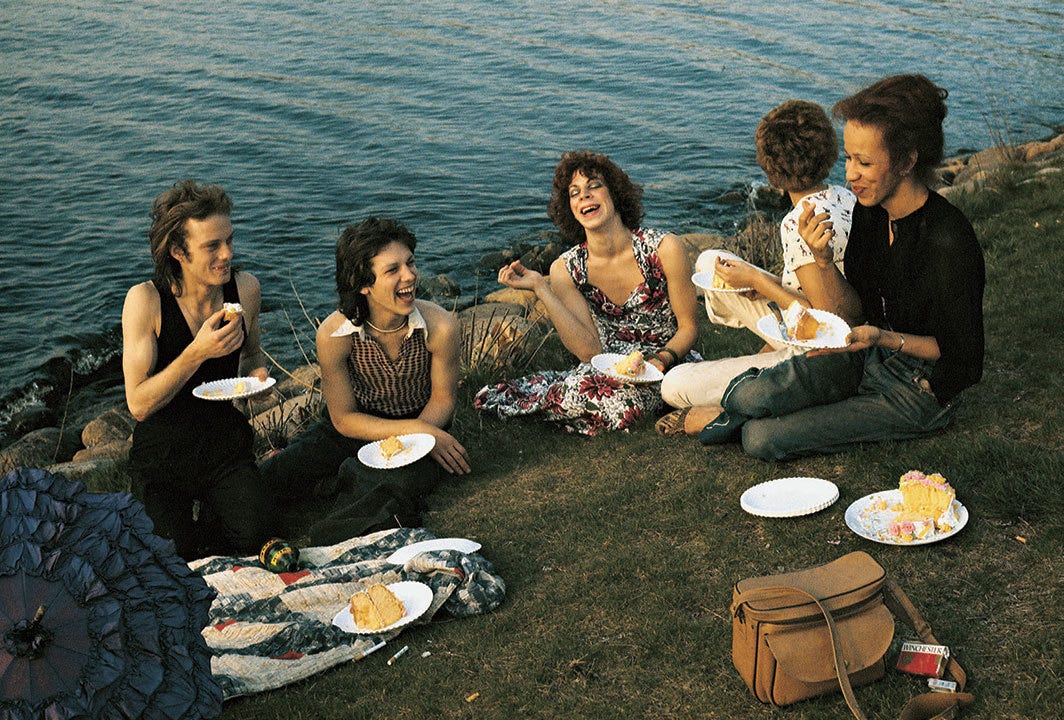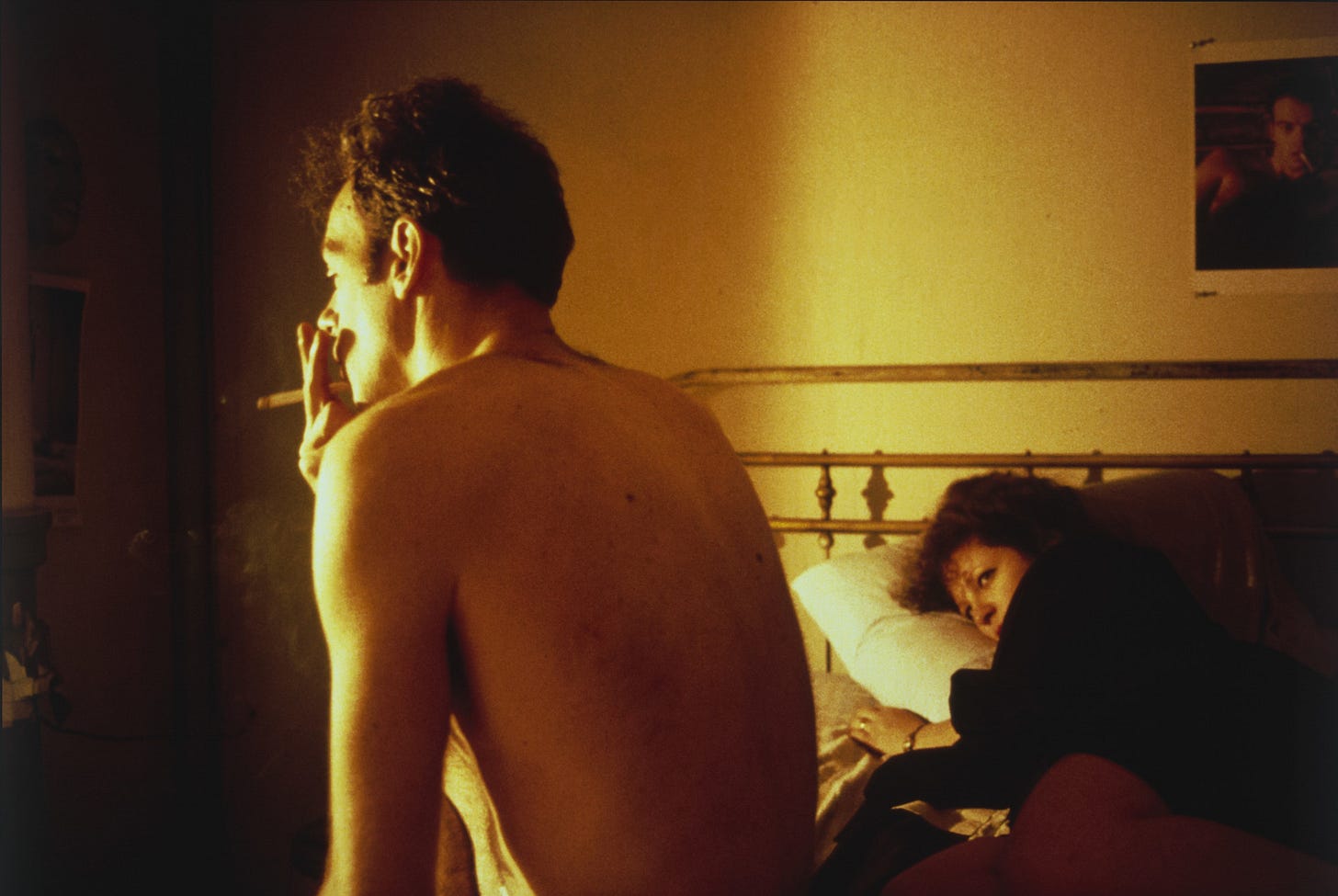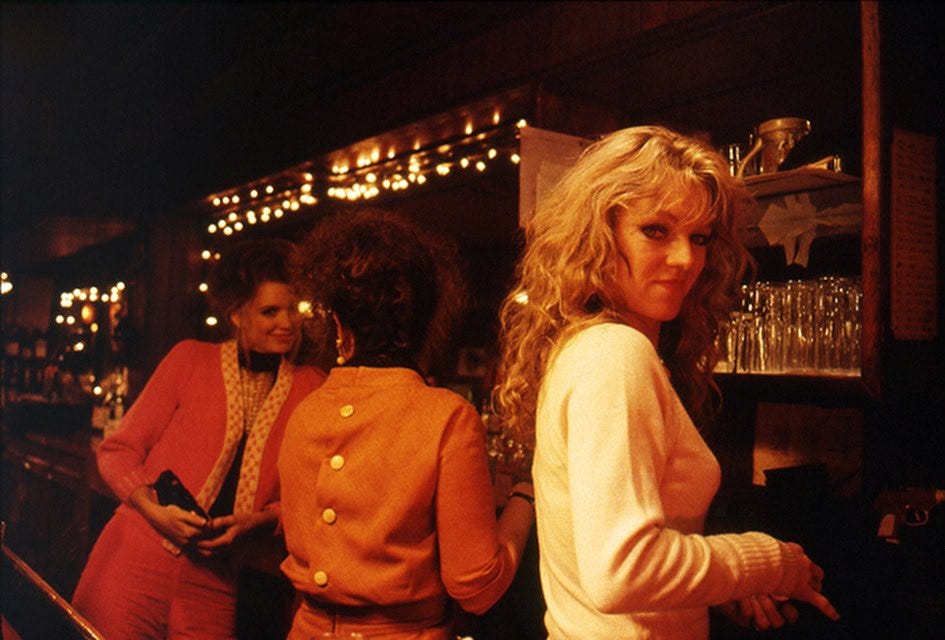“For me it is not a detachment to take a picture. It’s a way of touching somebody—it’s a caress, I think that you can actually give people access to their own soul.”
Nan Goldin’s art and life are deeply entwined; her ability to turn her life into art, her art into activism, and her activism into life-altering change cannot be underplayed. She is a singular artist, one of the twentieth century’s most important. It is impossible not to be moved by her work.
Nan forged a career in a patriarchal industry that told her ‘there is no such thing as a good woman artist,’ who didn’t like, or didn’t understand, her photographs. Her work is many things. Stark and revealing, absolutely, but also loving, cinematic, erotic, often lush, political, and always brimming with tenderness and desire. She shows pain and pleasure with brutal and unflinching honesty, without shame and pretence, devoid of embarrassment.
So much of her art functions as a time capsule of people and places no longer here. “I used to think that I could never lose anyone if I photographed them enough,” she once said. “In fact, my pictures show me how much I’ve lost.”
Laura Poitras’ extraordinary Academy Award-nominated documentary All the Beauty and the Bloodshed (2022) is out in UK cinemas on Friday. I watched a preview two weeks ago at my local independent cinema, one of six people present in a screening room with a capacity of 95. An invitation-only event for local writers and reviewers, I was the only woman present, the first to arrive, and the only one who chose to sit in the front row, or anywhere near the screen. Everyone else sat in the three back rows, but mostly the back row. I don’t always sit front and centre, but I’m pretty small, under 5ft tall, and I didn’t want anything, or anyone, obstructing my view of the film and the images I was about to see. In hindsight, this decision, which you may deem to be an unnecessary addition to this piece, added to the intimacy of the film.
All the Beauty and the Bloodshed is as much a Nan Goldin career retrospective as a documentary of activism and tribute to Nan’s late sister Barbara. I have seen comments saying the documentary feels like a few disparate films about Nan Goldin woven into one. However, I see Nan’s art, history, and activism as connected. Her photography seeks to destigmatise the marginalised, the queer community, addicts, transvestites, friends who lost their lives to the AIDS epidemic, and those fighting drug dependency. Nan Goldin beat addiction, but so many others didn’t, and it is difficult not to be affected by Poitras’ documentary.
The film, which has already won the Leone d’oro Golden Lion at the 2022 Venice Film festival, functions as a Nan Goldin retrospective and a document of her grassroots activism to take down the Sackler family and their accountability in the opioid crisis. The owners of Perdue Pharma, the Sacker’s wealth — accumulated through manufacturing and overprescription of OxyContontin — has made the family millions of dollars, and cost millions of lives. Using recently shot new footage of Nan’s activist group P.A.I.N. (Prescription Addiction Intervention Now), we see their campaigns to destigmatise addiction, and acquire more funding and resources for those working to beat their habits and in recovery. In the documentary, we see the various protests by Nan and group members at various galleries worldwide, including New York’s The MET and Guggenheim. Two lynchpins of the art world who have taken numerous sizeable monetary donations from the Sackler Family over the years.
Nan’s extraordinary photographic series The Ballad of Sexual Dependency features heavily in the film. Men didn’t like it; many wanted it stopped. Consisting of 700 snapshots taken between 1979 and 1986, the often candid portraits soundtracked to music and using photographs taken in Boston, New York, Berlin, and elsewhere, remains one of Nan's most revered works. To quote from the MoMA website:
Titled after a song in Bertolt Brecht and Kurt Weill’s The Threepenny Opera, Goldin’s Ballad is itself a kind of downtown opera; its protagonists—including the artist herself—are captured in intimate moments of love and loss. They experience ecstasy and pain through sex and drug use; they revel at dance clubs and bond with their children at home; and they suffer from domestic violence and the ravages of AIDS.
“‘The Ballad of Sexual Dependency’ is the diary I let people read,” Nan wrote. “The diary is my form of control over my life. It allows me to obsessively record every detail. It enables me to remember.” The beauty of Ballad lies in its intransigence. When Nan used to screen the images as a film carousel to friends, people would cheer or clap or complain about how they looked, and she would subsequently edit the film according to their concerns. The Ballad of Sexual Dependency has become a time capsule, a snapshot of New York's Bowery neighbourhood and a time that doesn't exist anymore. The overriding theme is one of community and tenderness but also love. Love and impermanence.
Also magnifying The Ballad of Sexual Dependency’s impermanence are those known within and outside Nan's work who lost their lives to AIDS or addiction. One such individual was the actress and art critic Cookie Mueller, who passed away from AIDS-related pneumonia in November 1989. A much-loved individual, heartbreakingly, Cookie died two months after her husband Vittorio Scarpati, a gentle Southern Italian artist who Nan described as the love of Cookie's life, lost his fight against AIDS. In an extraordinary act of activism until the end, Vittorio, an accomplished cartoonist, documented the couple’s fight from his hospital bed. After he died, Cookie's former partner Sarah, came back to care for Cookie, nursing her as she faded away. Nan described it as an incredible and selfless act of love.
Defiance and vulnerability are consistent in Nan’s work. In one series of self-portraits, she is seen with a massive black eye and broken eye socket after being horrifically beaten by a lover who destroyed most of her work and possessions. She described it as “the struggle between autonomy and dependency.” The friend who dragged her to safety informed Nan that he was “seeking to blind her,” yet Nan's honesty and her dark purple bruises and blood-red eyes gave other women the strength to walk away from their own abusive relationships.
Nan had a sister, Barbara, whose life ended in suicide when Nan was 11 years old. In an interview with the Guardian in 2014, Nan stated something that she reiterated in the documentary:
“My sister taught me to hate suburbia from a very young age. The suffocation, the double-standards. ‘Don't let the neighbours know’, was the gospel. Well, the neighbours certainly knew what was going on in our house, because they heard it.”
Much like Nan, who rebelled against the art world, Barbara rebelled against the stifling repression of middle-class American respectability and what was expected of young women. Familial neglect saw her Barbara’s autonomy stripped away as she was moved around orphanages and institutions, places she did not need to be. During one of her many psychiatric assessments, one doctor — aside from deducing that she was a regular adolescent girl whose mother should have been institutionalised instead of her daughter — wrote, “she sees it all. All the beauty and the Bloodshed.”
Much like one of Nan’s images, I have not stopped thinking about All the Beauty and the Bloodshed since I watched it. When I went to the Multiplex on Sunday, the trailer aired before the main feature, and I was seconds away from urging the couple behind me to watch the documentary. Instead, I Tweeted it out urgently. One friend replied, saying she would bump the documentary to the top of her watchlist. If I can get one of you reading this to watch it, I feel I will have accomplished something.
The photography writer Bill Shapiro wrote a similar urging message on his Instagram page recently. Under a carousel of Nan’s images, he summed everything up perfectly:
Nan Goldin is, of course, a brilliant photographer. She is also a radical, a rebel, an activist, an organizer, a former oxy addict and sex worker, a victim, a survivor, a sister, and one more thing: Nan Goldin is a fucking hero.











